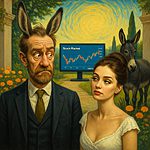
Example of Groupthink: The Perils of Panic Selling
Introduction
April 29, 2024
Mob psychology plays a significant role in investing. It refers to the herd mentality, where individuals follow the crowd and make decisions based on the actions of others. This collective mindset can sway markets and shape investment decisions, often leading to irrational behaviour.
During market declines, for instance, groupthink can result in panic-based sell-offs, amplifying losses for those caught in the wave. This phenomenon has been studied for decades, tracing back to the early days of stock market trading. Understanding and navigating this psychological landscape can be the key to success in the ever-changing world of finance.
However, a counterbalance to this collective mindset exists in contrarian investing. Contrarian investors aim to capitalize on the irrationality of the masses by taking positions that run counter to the overall market sentiment. They believe that when most investors are overly optimistic or pessimistic, it can lead to mispricings and opportunities for profit.
By exploring groupthink psychology, we can delve into the intricacies of this phenomenon and its impact on investment decisions. We can uncover the allure and dangers of following the crowd and the potential rewards for those who dare to break away from the herd.
Understanding the workings of mass psychology and adopting a contrarian approach can help investors confidently navigate the market and seek out opportunities that may have been overlooked. By doing so, they can potentially profit from market inefficiencies created by overreactions to news and events.
The power of groupthink psychology in investing is undeniable. However, investors can use this power to make more informed and profitable investment decisions by understanding this phenomenon and adopting a contrarian approach.
Dancing with the Market: Contrarian Steps to Financial Success
Understanding the intricacies of mass psychology and its influence on the stock market can be an investor’s secret weapon. The concept of groupthink, or herd mentality, has long been studied, with its roots tracing back to the early days of stock market trading. This phenomenon often leads to investors making panic-driven decisions, especially during market downturns.
Contrarian investing presents a compelling strategy for navigating this challenge. By going against the grain and making decisions contrary to the prevailing market sentiment, contrarian investors aim to exploit moments when the market overreacts and identify opportunities others may have missed. This approach requires discipline, patience, and a long-term vision, often involving swimming against the current.
The renowned economist John Maynard Keynes recognized this behaviour in the 1940s, coining the term “animal spirits” to describe investors’ unpredictable and emotionally driven decisions. Today, this insight remains pertinent, reminding us that the collective psyche plays a pivotal role in market movements.
History has repeatedly shown the pitfalls of succumbing to panic. Those who hastily sell during market declines often miss the subsequent recovery. At the same time, those who remain calm and retain their investments reap the benefits of the inevitable market upswing. This pattern has been observed repeatedly, emphasizing the importance of rational decision-making.
In the words of Warren Buffett, one of the world’s most successful investors, “Be fearful when others are greedy, and greedy when others are fearful.” This quote encapsulates the essence of contrarian investing, highlighting the importance of maintaining a level head during market extremes.
Additionally, behavioural economics provides further insights into the groupthink phenomenon. Researchers have found that individuals often seek confirmation bias when making decisions, reinforcing their existing beliefs and following the crowd. However, investors can make more rational choices by recognizing this bias and actively seeking diverse perspectives.
The power of contrarian investing lies in its ability to uncover hidden gems. It encourages investors to look beyond the obvious, identify undervalued investments, and capitalize on opportunities that the myopic gaze of the majority may overlook. This strategy has the potential to pave the way for higher returns and long-term financial prosperity.
Navigating the Currents of Groupthink
Navigating the currents of groupthink is essential in investing. The pervasive mass mindset often leads to financial missteps, as investors sell when opportunity knocks and buy when caution signals.
Breaking away from groupthink requires more than mere knowledge; it demands the courage to challenge the status quo and embrace unconventional thinking. It’s about recognizing the thin line between genuine knowledge and the illusion of knowledge.
The journey toward financial independence involves shedding the shackles of conventional wisdom and venturing into uncharted territories. It’s a realm where innovation reigns supreme, and the rewards go beyond the mundane.
The late psychologist Irving Janis, who coined “groupthink,” emphasized the importance of independent thinking in decision-making. In his seminal work “Groupthink,” Janis wrote, “The more amiability and esprit de corps among the members of a policy-making in-group, the greater is the danger that independent critical thinking will be replaced by groupthink.”
Janis’s insights underscore the need for investors to break free from the echo chamber of consensus and forge their path. By embracing the role of the devil’s advocate, questioning assumptions, and seeking diverse perspectives, investors can mitigate the risks of groupthink and make more informed decisions.
The Dot-Com Bubble
The late 1990s saw the advent of the Internet, a revolutionary technology promising to reshape the world as we knew it. This era, often called the “dot-com bubble,” was characterized by a surge in equity investments in internet-based companies or “dot-coms.” This investment frenzy was fueled by the collective belief that the Internet represented a new business paradigm, and traditional company valuation metrics were deemed obsolete.
This collective belief is a classic example of groupthink psychology in action. Groupthink, a term coined by social psychologist Irving Janis, refers to a psychological phenomenon where people strive for consensus within a group, often disregarding their doubts and beliefs. In the case of the dot-com bubble, investors were swept up in the euphoria of this new technological frontier. The fear of missing out (FOMO) on the potential profits led to a herd mentality, where investors blindly followed the crowd, pouring money into these dot-coms and pushing their stock prices to astronomical levels.
Media hype, bullish analyst reports, and tales of overnight millionaires further reinforced this group behaviour, creating an echo chamber that amplified optimism and suppressed scepticism. However, the dot-com party didn’t last. By 2000-2001, it became apparent that many of these internet companies were not profitable despite their high stock prices and had unsustainable business models. The bubble burst, leading to a dramatic crash in stock prices known as the “dot-com crash.”
The 2008 Housing Market Crash: A Cautionary Tale
The years leading up to the 2008 financial crisis saw a booming housing market, with home prices on a seemingly unstoppable upward trajectory. Easy credit and lax lending standards fueled a surge in home buying and mortgage lending, even to borrowers with poor credit histories.
Groupthink played a significant role in this crisis. The collective belief in the housing market’s infallibility led to risky lending and investment practices, with banks offering mortgages to individuals unlikely to repay them. The media and financial analysts reinforced this optimism, creating an echo chamber that suppressed scepticism.
However, when interest rates rose in the mid-2000s, many homeowners defaulted on their mortgages, causing the housing bubble to burst. The fallout from this crash spilt over into the broader economy, leading to the worst recession since the Great Depression.
The Renaissance polymath **Leonardo da Vinci** once said, “It is easier to resist at the beginning than at the end.” This sage advice is particularly relevant to the 2008 housing market crash. Had more individuals and institutions resisted the allure of easy profits and maintained a critical perspective on the unsustainable growth in housing prices, the severity of the crisis might have been mitigated.
Da Vinci’s wisdom underscores the importance of independent thinking and rigorous analysis when making investment decisions. It also reminds us to be cautious of the herd mentality, particularly in complex and interconnected markets like housing and finance.
The GameStop Saga: A Clash of Wills
In early 2021, GameStop, a struggling video game retailer, became the unlikely battleground between Wall Street hedge funds and retail investors from the Reddit forum r/wallstreetbets. These retail investors rallied behind GameStop, buying shares en masse to trigger a ‘short squeeze’ against hedge funds betting on the company’s decline. Fueled by anti-establishment sentiment and speculative fervour, GameStop’s stock price skyrocketed, causing substantial losses for short-selling hedge funds.
The GameStop frenzy exemplifies groupthink, a psychological phenomenon where group members strive for consensus and ignore dissenting views. In the echo chamber of r/wallstreetbets, the mantra ‘hold the line’ reverberated, encouraging members to keep buying and holding GameStop shares despite inflated prices and shaky fundamentals. The collective belief in taking on Wall Street titans and turning the tables on professional short sellers strengthened the group’s resolve.
GameStop’s stock price plummeted as the frenzy cooled, leaving many retail investors with significant losses. This dramatic turn underscored the risks of following the herd and neglecting rational analysis.
The GameStop saga echoes the timeless wisdom of ancient traders. In ancient Greece, Thales of Miletus, a philosopher and mathematician, used his knowledge of astronomy to predict a bumper olive harvest. He secured the rights to use all the olive presses in Miletus and Chios, only to rent them out at a premium when demand soared. Thales demonstrated the importance of independent analysis and contrarian thinking in making profitable trades.
Another example comes from ancient China, where Fan Li, a prosperous merchant and advisor, emphasized the importance of adaptability in changing market conditions. Fan Li’s principle of “buy when there is blood in the streets, even if the blood is your own” highlights the value of maintaining a long-term perspective and being prepared to capitalize on opportunities during market downturns.
Conclusion: Mastering the Market Symphony Through Individuality
In the grand orchestration of the stock market, grasping the intricacies of groupthink psychology emerges as a pivotal chord for investment success. The problematic dance of the herd often leads to chaotic selloffs and regrettable decisions, casting shadows of losses for those entangled in collective behaviour.
Enter the contrarian maestro, wielding a strategy that capitalizes on market overreactions and unearths hidden treasures overlooked by the crowd. While not foolproof, it becomes a compass for navigating the irrational waves stirred by the masses.
Resisting panic-driven selloffs becomes the anthem for sustained growth. Those who weather market declines with poise reap the rewards of eventual recovery, while the panic-stricken are left behind. It’s a testament to the enduring power of staying calm amid market turbulence.
The wisdom of John Maynard Keynes reverberates through time—his recognition of the influential “animal spirits” shaping the market echoes in the actions of today’s masses. Discipline becomes the guardian against impulsive herding, fostering resilience against market unpredictability.
Other Articles Of Interest
Dark Pools Stock Market: Unveiling Manipulation and Thievery














